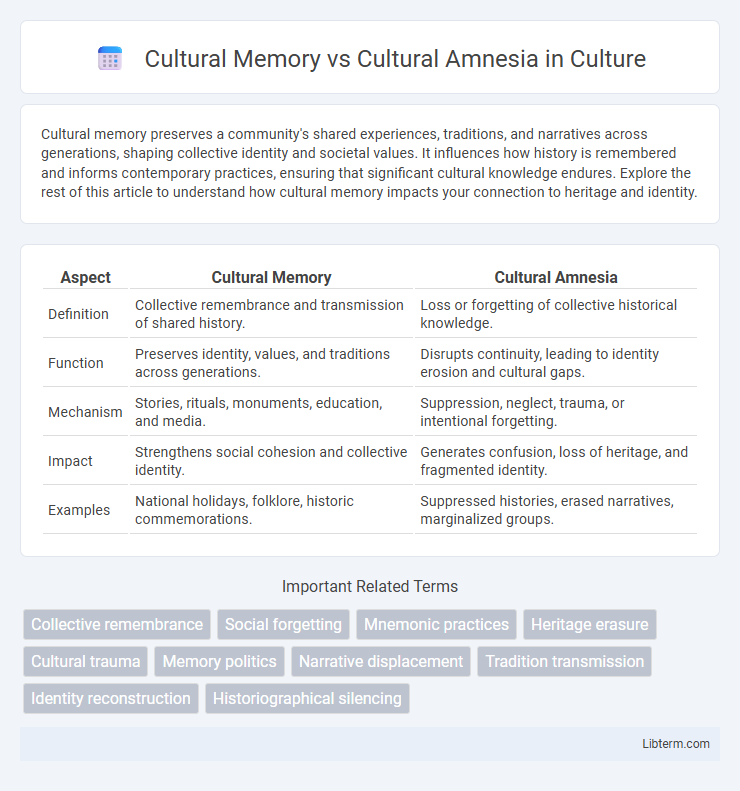Cultural memory preserves a community's shared experiences, traditions, and narratives across generations, shaping collective identity and societal values. It influences how history is remembered and informs contemporary practices, ensuring that significant cultural knowledge endures. Explore the rest of this article to understand how cultural memory impacts your connection to heritage and identity.
Table of Comparison
| Aspect | Cultural Memory | Cultural Amnesia |
|---|---|---|
| Definition | Collective remembrance and transmission of shared history. | Loss or forgetting of collective historical knowledge. |
| Function | Preserves identity, values, and traditions across generations. | Disrupts continuity, leading to identity erosion and cultural gaps. |
| Mechanism | Stories, rituals, monuments, education, and media. | Suppression, neglect, trauma, or intentional forgetting. |
| Impact | Strengthens social cohesion and collective identity. | Generates confusion, loss of heritage, and fragmented identity. |
| Examples | National holidays, folklore, historic commemorations. | Suppressed histories, erased narratives, marginalized groups. |
Understanding Cultural Memory: Foundations and Significance
Cultural memory refers to the collective capacity of a society to preserve and transmit knowledge, traditions, and shared experiences across generations, forming the foundation of cultural identity. It encompasses rituals, symbols, and narratives that anchor communal values and historical consciousness, enabling societies to maintain continuity and coherence over time. Understanding cultural memory is crucial for recognizing how collective remembrance shapes social cohesion, influences identity formation, and impacts intercultural dialogue.
The Nature and Causes of Cultural Amnesia
Cultural amnesia refers to the collective forgetting or distortion of significant historical events, traditions, and knowledge within a society, often caused by political repression, ideological shifts, or trauma. This phenomenon disrupts cultural memory by erasing shared experiences and undermining identity continuity, leading to a loss of historical awareness and social cohesion. Mechanisms such as censorship, propaganda, generational trauma, and selective educational practices play crucial roles in fostering cultural amnesia across communities.
Collective Identity: The Role of Shared Memories
Collective identity is deeply influenced by the dynamic interplay between cultural memory and cultural amnesia, where shared memories preserve historical experiences and shape communal values across generations. Cultural memory functions as a repository of collective narratives that reinforce group cohesion, while cultural amnesia selectively forgets or suppresses certain events, impacting identity formation and social continuity. The balance between remembrance and forgetting critically determines how societies construct their collective identities and navigate past traumas or triumphs.
Historical Narratives: Remembering vs. Forgetting
Historical narratives shape collective identity by selectively remembering events that reinforce cultural values, while cultural amnesia involves the deliberate forgetting or marginalization of uncomfortable or conflicting pasts. The tension between remembering and forgetting influences how societies confront trauma, injustice, and heritage, impacting intergenerational understanding and reconciliation. Scholars emphasize that balancing cultural memory and amnesia is crucial for constructing inclusive historical accounts that honor diverse perspectives and foster social cohesion.
Media Influence on Cultural Memory and Amnesia
Media plays a pivotal role in shaping cultural memory by selecting, framing, and disseminating collective experiences and historical narratives, thus reinforcing shared identities. It can also contribute to cultural amnesia by marginalizing or erasing certain events, voices, and perspectives, leading to gaps in collective knowledge and understanding. Digital platforms and mainstream media shape public consciousness, determining which memories persist and which are forgotten in societal discourse.
Education Systems: Preserving or Erasing Cultural Knowledge
Education systems play a crucial role in shaping cultural memory by integrating diverse historical narratives and traditional knowledge into curricula, thereby preserving collective identity and heritage. Conversely, cultural amnesia occurs when educational frameworks omit or marginalize certain histories, leading to a loss of cultural awareness and continuity. The balance between preserving cultural memory and risking cultural amnesia depends on inclusive educational policies that recognize and validate multiple cultural perspectives.
Intergenerational Transmission of Cultural Memory
Intergenerational transmission of cultural memory involves passing down collective knowledge, values, and traditions through storytelling, rituals, and education, ensuring cultural continuity across generations. Cultural amnesia occurs when this transmission is disrupted, leading to loss of historical awareness and weakening of communal identity. Maintaining robust intergenerational communication is crucial to preserving cultural memory and preventing the erasure of heritage in societies.
Globalization and the Erosion of Local Memory
Globalization accelerates the erosion of local cultural memory by promoting homogenized values and norms that often overshadow unique regional histories and traditions. Cultural amnesia emerges as communities lose connection to their indigenous languages, rituals, and narratives, replaced by a dominant global culture that prioritizes economic and technological advancement. This dynamic challenges the preservation of diverse identities, risking the disappearance of cultural heritage that is vital for social cohesion and historical consciousness.
Revival Movements: Combatting Cultural Amnesia
Revival movements play a critical role in combatting cultural amnesia by actively restoring and preserving traditional customs, languages, and practices that risk being forgotten. These movements often utilize education, media, and community engagement to reinforce collective memory and cultural identity. Examples include the Gaelic language revival in Ireland and the Native American cultural reclamation efforts, which exemplify how cultural memory is revitalized to strengthen communal bonds and historical awareness.
The Future of Cultural Memory in a Digital Age
The future of cultural memory in a digital age hinges on the preservation and accessibility of vast digital archives, which shape collective identity and historical consciousness. Advances in artificial intelligence and blockchain technology offer innovative methods to authenticate and sustain cultural artifacts, mitigating risks of cultural amnesia. Digital platforms enable dynamic, interactive storytelling that democratizes memory, but also require vigilant curation to prevent fragmentation and misinformation.
Cultural Memory Infographic

 libterm.com
libterm.com